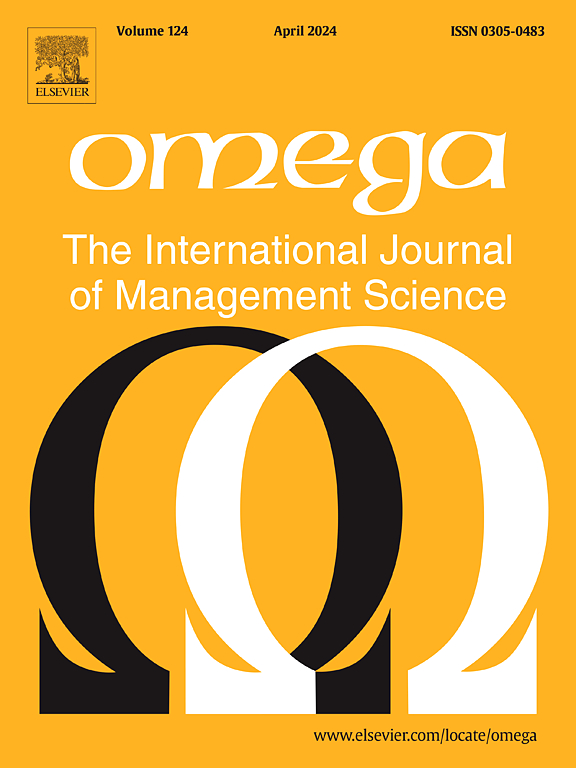在急诊科登记时使用远程分诊对住院风险进行建模
IF 7.2
2区 管理学
Q1 MANAGEMENT
Omega-international Journal of Management Science
Pub Date : 2025-06-07
DOI:10.1016/j.omega.2025.103381
引用次数: 0
摘要
准确和及时的患者分层在急诊科(ED)是必要的有效的医院操作和改善患者护理。急诊科的患者分层通常依赖于分诊信息的可用性,分诊信息评估患者的敏锐度,由临床工作人员执行。然而,分诊是在病人在急诊科登记后进行的,很容易出现延误和中断。分诊延误与患者护理和预后差有关,特别是对于需要从急诊科转到医院的高敏度患者。这促使我们在论文中预测分诊前阶段的分诊类别,即患者到达急诊科登记时的分诊类别。我们将预测的分诊称为TeleTriage,因为它可以远程管理。然后,我们使用TeleTriage以及其他相关功能来模拟患者需要从急诊科进入医院的概率。使用机器学习,我们专注于在注册时估计这种入院风险,以便及早识别需要入院的患者,并更快地开始下游任务。我们使用内部和外部验证方案评估了我们的建模方法,并考虑了与急诊科患者入院相关的决策成本的不对称。我们证明,所提出的建模框架可以帮助减少决定患者是否需要入院的时间,从而减少高敏度患者的住院时间,减轻等待时间目标对入院的影响。本文章由计算机程序翻译,如有差异,请以英文原文为准。
Using teletriage to model the risk of hospital admission at the time of registration in an emergency department
Accurate and timely stratification of patients at an emergency department (ED) is imperative for efficient hospital operations and improved patient care. Patient stratification at an ED typically relies on the availability of triage information, which assesses patient acuity and is performed by clinical staff. However, triaging takes place after patient registration at the ED, and is prone to delays and interruptions. Delays in administering triage are associated with poor patient care and outcomes, especially for high-acuity patients who need to be admitted from the ED to the hospital. This motivates us, in the paper, to predict the triage category in the pre-triage phase, at the time of registration when patients arrive at the ED. We refer to the predicted triage as TeleTriage, as it can be administered remotely. We then use TeleTriage, along with other relevant features, to model the probability of a patient needing admission from the ED to the hospital. Using machine learning, we focus on the estimation of this admission risk at the time of registration, to enable early identification of patients needing admission, and the start of downstream tasks sooner. We evaluate our modelling approach using internal and external validation schemes across patient conditions, and we accommodate the asymmetric costs of decision-making associated with patient admissions at the ED. We demonstrate that the proposed modelling framework can help reduce the time taken to decide if a patient needs admission, thereby reducing the length of stay for high-acuity patients and mitigating the impact of waiting time targets on admissions.
求助全文
通过发布文献求助,成功后即可免费获取论文全文。
去求助
来源期刊

Omega-international Journal of Management Science
管理科学-运筹学与管理科学
CiteScore
13.80
自引率
11.60%
发文量
130
审稿时长
56 days
期刊介绍:
Omega reports on developments in management, including the latest research results and applications. Original contributions and review articles describe the state of the art in specific fields or functions of management, while there are shorter critical assessments of particular management techniques. Other features of the journal are the "Memoranda" section for short communications and "Feedback", a correspondence column. Omega is both stimulating reading and an important source for practising managers, specialists in management services, operational research workers and management scientists, management consultants, academics, students and research personnel throughout the world. The material published is of high quality and relevance, written in a manner which makes it accessible to all of this wide-ranging readership. Preference will be given to papers with implications to the practice of management. Submissions of purely theoretical papers are discouraged. The review of material for publication in the journal reflects this aim.
 求助内容:
求助内容: 应助结果提醒方式:
应助结果提醒方式:


